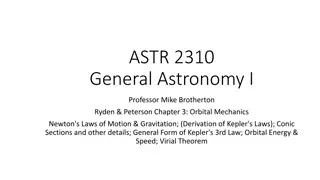Evolution of Motion Theories: Aristotle to Einstein
Explore the progression of motion theories from Aristotle's belief in a force for motion to Galileo's discoveries on gravity, Newton's laws of motion, and Einstein's theories of relativity and quantum mechanics. Discover how our understanding of motion has evolved over the centuries, shaping the way we perceive the natural world.
Download Presentation

Please find below an Image/Link to download the presentation.
The content on the website is provided AS IS for your information and personal use only. It may not be sold, licensed, or shared on other websites without obtaining consent from the author.If you encounter any issues during the download, it is possible that the publisher has removed the file from their server.
You are allowed to download the files provided on this website for personal or commercial use, subject to the condition that they are used lawfully. All files are the property of their respective owners.
The content on the website is provided AS IS for your information and personal use only. It may not be sold, licensed, or shared on other websites without obtaining consent from the author.
E N D
Presentation Transcript
CH-4: Newtons Laws: Explaining Motion Brief History Aristotle (384-322 B.C) Galileo Galilei (1564-1642) Isaac Newton (1642-1727) Albert Einstein (1879 1955) Newton s laws of motion: 1stlaw, 2ndlaw, 3rdlaw Applications of Newton s laws CH-5: Centripetal Force Newton s Law of gravitation
Aristotle (384-322 B.C) Believed that a force had to act for an object to move. Did not distinguish acceleration from velocity. Believed that a heavy object would fall more quickly than a lighter object. Earth-centered model of the solar system.
Galileo Galilei (1564-1642) Advocated Copernicus s Sun-centered model of the solar system. Showed that heavy and light objects fell at the same rate. Argued that no force is required to maintain motion. Developed mathematical description of motion.
Isaac Newton (1642-1727) Laws of motion, can be used to analyze motion of ordinary objects. Not valid for speeds close to the speed of light. Need to use the theory of relativity. Not valid for atomic sized particles. Need to use quantum mechanics.
Albert Einstein (18791955) At the beginning of the 20th century, Albert Einstein (1879 1955) developed the theory of relativity and, along with many other scientists, developed quantum theory. This theory does not have the constraints present in classical physics.
Newtons First Law of Motion http://www.ispot.tv/ad/7V7z/ celebrex-body-in-motion An object remains in a state of rest or in a state of motion at a constant speed along a straight line, unless it is compelled to change that state by a net force.
Newton's Second Law of Motion When a net external force F acts on an object of mass m, the acceleration a that results is directly proportional to the net force and has a magnitude that is inversely proportional to the mass. The direction of the acceleration is the same as the direction of the net force. SI Unit of Force: kg m/s2 = newton (N)
The Concept of Force In common usage, a force is a push or a pull. Forces can be categorized as, Contact forces and Non-Contact forces.
Mass and Weight The weight of an object on the earth is the gravitational force that the earth exerts on the object. The weight always acts downward, toward the center of the earth. On another astronomical body, the weight is the gravitational force exerted on the object by that body. Weight = Mass x Gravity SI Unit of Weight: : newton (N) Ex: How much one may weigh in moon?
Why is the gravitational acceleration is independent of mass?
Newtons Third Law If object A exerts a force on object B, object B exerts a force on object A that is equal in magnitude but opposite in direction to the force exerted on B.
Example Suppose that the mass of the spacecraft in is mS = 11 000 kg and that the mass of the astronaut is mA = 92 kg. In addition, assume that the astronaut exerts a force of P = +36 N on the spacecraft. Find the accelerations of the spacecraft and the astronaut. Astronauts use a tether to stay connected to the space capsule.
Identifying Forces Textbook resting on a table Object resting on an inclined plane Mass hanging on a string Ladder on a wall
Does a sky diver continue to accelerate?
Motion of Connected Objects m1= 10 kg m2= 8 kg a. What is the acceleration of the two carts? b. What is the net force acting on each cart? Atwood s Machine: Q32, Ch-4
CH-5: Centripetal Acceleration (ac) and Force (Fc) Q: Consider a ball of mass, m twirled in a horizontal circle at constant speed, v. Is there any acceleration? A: Yes. Centripetal Acceleration Centripetal acceleration is the rate of change in velocity of an object that is associated with the change in direction of the velocity. It is always perpendicular to the velocity vector and points toward the center of the curve. Fc= 2 v 2 mv ac= . . r r
CH-5: Newtons Law of Universal Gravitation m m G F = 2 . N m 11 = ; . 6 67 10 1 r 2 G 2 2 Kg Every body in the universe attracts every other body with a force that is directly proportional to the product of the masses of the bodies and inversely proportional to the square of the distance between the bodies. The law of gravitation is universal and very fundamental. It can be used to understand the motions of planets and moons, determine the surface gravity of planets, and the orbital motion of artificial satellites around the Earth.
Gravity and Satellite Calculating the Earth s acceleration due to gravity. Calculating the speed of orbiting International Space Station.























